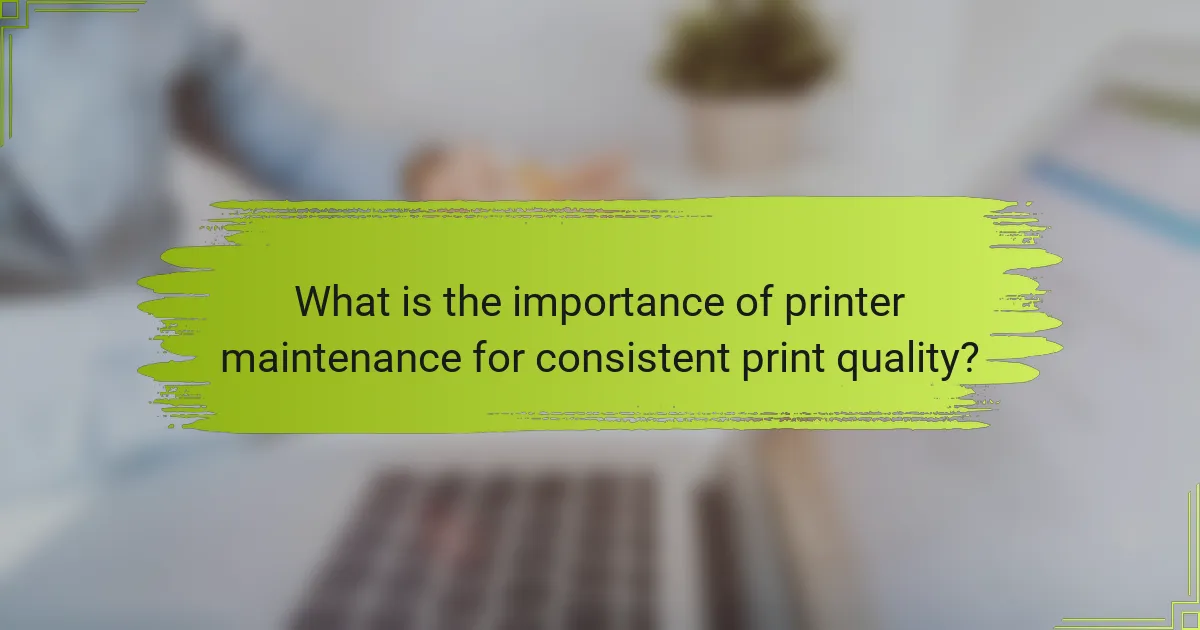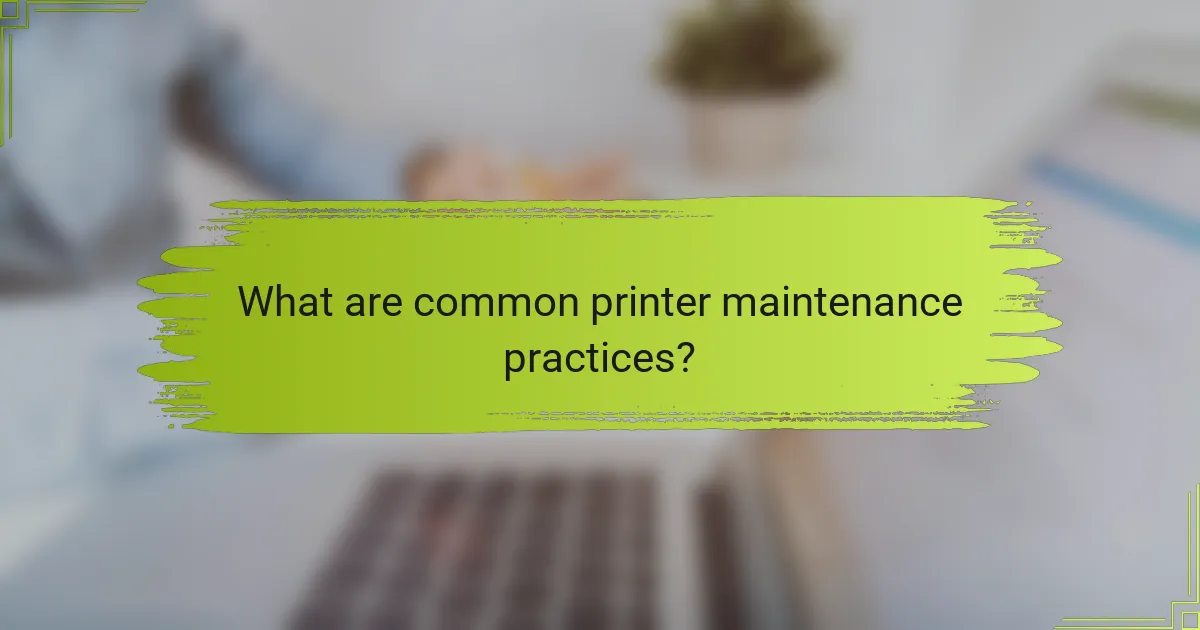
What is the importance of printer maintenance for consistent print quality?
Printer maintenance is crucial for achieving consistent print quality. Regular maintenance prevents issues such as ink smudging and paper jams. It ensures that print heads are clean and functioning properly. Clean print heads lead to sharper and more vibrant prints. Additionally, maintaining appropriate ink levels prevents color discrepancies. Scheduled maintenance can extend the lifespan of the printer. According to a study by the International Imaging Technology Council, proper maintenance can improve print quality by up to 30%. This highlights the direct relationship between maintenance and print performance.
How does regular printer maintenance impact print quality?
Regular printer maintenance significantly enhances print quality. It ensures that components like print heads and nozzles remain clean and functional. Clean print heads prevent clogs that can lead to streaks or faded prints. Regularly replacing worn parts maintains optimal performance. Additionally, routine checks can identify issues before they affect output. According to a study by the International Journal of Printing Technology, printers that undergo regular maintenance produce 30% fewer print defects. This demonstrates that consistent upkeep directly correlates with improved print quality.
What specific maintenance tasks contribute to improved print quality?
Regular maintenance tasks that contribute to improved print quality include cleaning the print head, aligning the print head, and replacing ink or toner cartridges. Cleaning the print head removes dried ink that can cause streaks. Aligning the print head ensures accurate placement of ink on the paper. Replacing ink or toner cartridges prevents faded prints due to low ink levels. Additionally, regularly checking and cleaning the printer rollers helps avoid paper jams and misfeeds, which can affect print quality. These tasks are essential for maintaining optimal printer performance and achieving high-quality prints consistently.
How does neglecting maintenance affect print outcomes?
Neglecting maintenance leads to poor print outcomes. It can result in issues such as streaks, smudges, and inconsistent colors. Regular maintenance ensures that print heads are clean and functioning properly. When maintenance is ignored, dust and debris accumulate. This buildup can block ink flow and cause misalignment. Studies show that printers without regular maintenance have a higher failure rate. For instance, according to a survey by the International Imaging Technology Council, 70% of print quality issues are linked to lack of maintenance. Proper upkeep extends the lifespan of printers and improves overall print quality.
Why is consistent print quality crucial for businesses?
Consistent print quality is crucial for businesses because it directly impacts brand perception and customer satisfaction. High-quality prints reflect professionalism and attention to detail. Inconsistent print quality can lead to miscommunication and errors in important documents. Research shows that 75% of customers judge a company’s credibility based on its printed materials. Businesses that maintain consistent print quality are more likely to retain clients and enhance their reputation. Additionally, consistent print quality reduces waste and costs associated with reprints. Therefore, maintaining printer performance is essential for achieving reliable output.
What are the potential costs of poor print quality?
Poor print quality can lead to significant costs for businesses. These costs include wasted materials and ink due to misprints or poor output. Companies may face increased labor costs as employees spend extra time reprinting documents. Additionally, poor print quality can damage a company’s reputation, leading to lost clients and reduced sales. Inconsistent branding due to low-quality prints may confuse customers. According to a study by InfoTrends, businesses can lose up to 20% of their revenue from poor print quality issues. This highlights the financial impact of not maintaining printers effectively.
How does print quality affect customer satisfaction and brand perception?
Print quality significantly impacts customer satisfaction and brand perception. High-quality prints enhance the visual appeal of materials. This leads to a positive customer experience and fosters trust in the brand. Conversely, poor print quality can cause dissatisfaction. It may result in negative perceptions about the brand’s professionalism and attention to detail. Research shows that 70% of customers associate print quality with overall brand quality. Consistent print quality reflects a commitment to excellence. This can differentiate a brand in a competitive market. Therefore, maintaining printers is crucial for ensuring high print quality and preserving brand integrity.

What are common printer maintenance practices?
Common printer maintenance practices include regular cleaning, checking ink or toner levels, and updating drivers. Cleaning involves removing dust and debris from the printer’s exterior and interior components. This prevents paper jams and ensures smooth operation. Checking ink or toner levels regularly helps avoid unexpected print outages. It ensures that the printer operates efficiently without interruptions. Updating printer drivers is essential for optimal performance. It ensures compatibility with the latest software and enhances functionality. Routine maintenance can extend the lifespan of the printer and improve print quality. Regularly scheduled maintenance can prevent costly repairs and downtime.
How often should printers be serviced for optimal performance?
Printers should be serviced every 6 to 12 months for optimal performance. Regular servicing helps maintain print quality and prevents malfunctions. The frequency can depend on usage levels and printer type. High-volume printers may require more frequent servicing. Regular maintenance can include cleaning, replacing worn parts, and updating software. According to manufacturers, consistent servicing can extend the lifespan of the printer. This practice ensures reliable operation and quality output.
What are the signs that a printer needs maintenance?
Signs that a printer needs maintenance include frequent paper jams. Paper jams indicate that the printer’s rollers or feed mechanisms may be worn or dirty. Another sign is poor print quality, such as streaks or faded prints. This often results from clogged print heads or low ink levels. Unusual noises during printing can also signal mechanical issues. Additionally, error messages on the printer display should not be ignored. Regularly checking for these signs helps maintain optimal printer function.
How can users perform basic maintenance tasks themselves?
Users can perform basic maintenance tasks on printers by regularly cleaning the print heads and cartridges. This prevents clogs and ensures optimal ink flow. Users should also check and replace ink or toner cartridges as needed. Regularly inspecting the printer for paper jams is essential to maintain smooth operation. Users can clean the exterior and interior surfaces with a soft, lint-free cloth. Updating printer drivers and software can enhance performance and compatibility. Running built-in maintenance utilities, such as print head alignment, helps maintain print quality. Following these steps can prolong the printer’s lifespan and improve print consistency.
What tools and supplies are necessary for printer maintenance?
Essential tools and supplies for printer maintenance include cleaning solutions, lint-free cloths, and compressed air. Cleaning solutions help remove ink and dust buildup. Lint-free cloths prevent scratches on printer surfaces. Compressed air clears debris from hard-to-reach areas. Additionally, replacement ink or toner cartridges are necessary for optimal printing performance. Regular maintenance tools like screwdrivers may be needed for internal access. These items ensure printers operate efficiently and maintain print quality.
Which cleaning materials are safe for printers?
Isopropyl alcohol and microfiber cloths are safe for printers. Isopropyl alcohol effectively removes ink and dust without damaging printer components. Microfiber cloths are gentle and prevent scratches on sensitive surfaces. Avoid using paper towels or rough fabrics, as they can leave lint or scratches. Using these materials helps maintain print quality and extends printer lifespan.
What tools are essential for printer upkeep?
Essential tools for printer upkeep include cleaning kits, replacement cartridges, and maintenance software. Cleaning kits typically contain lint-free cloths and cleaning solutions. These tools help remove dust and debris that can affect print quality. Replacement cartridges are necessary to ensure consistent ink flow. Regularly replacing cartridges prevents printhead clogs and fading. Maintenance software assists in diagnosing printer issues. It can provide alerts for maintenance tasks and updates. Using these tools can significantly enhance printer performance and longevity.

How can businesses implement effective printer maintenance strategies?
Businesses can implement effective printer maintenance strategies by establishing a regular maintenance schedule. This schedule should include routine cleaning and inspections of printers. Regularly replacing consumables like toner and ink cartridges is essential. Monitoring print quality can help identify issues early. Training staff on proper printer use can prevent misuse. Keeping printers in optimal environments reduces wear and tear. Utilizing diagnostic tools can streamline maintenance processes. According to a 2021 study by IDC, proactive maintenance can reduce printer downtime by up to 30%.
What are the best practices for developing a printer maintenance schedule?
Establishing a printer maintenance schedule involves several best practices. First, assess the printer’s usage frequency. Regularly used printers require more frequent maintenance. Next, define specific maintenance tasks, such as cleaning print heads and checking ink levels. Schedule these tasks at consistent intervals, like weekly or monthly. Document maintenance activities to track performance and identify trends. Use manufacturer guidelines for maintenance recommendations. Additionally, train staff on proper printer usage to prevent misuse. Following these practices enhances print quality and extends printer lifespan.
How can technology assist in managing printer maintenance?
Technology can assist in managing printer maintenance through automated monitoring systems. These systems track printer performance and alert users to potential issues. For instance, they can notify users when ink levels are low or when maintenance is due. Remote diagnostics can also identify problems before they escalate. This proactive approach minimizes downtime and extends printer lifespan. Additionally, software solutions can schedule regular maintenance tasks based on usage patterns. Studies show that regular maintenance can improve print quality by up to 30%. Therefore, leveraging technology enhances efficiency and reliability in printer management.
What role do employees play in maintaining printer quality?
Employees play a crucial role in maintaining printer quality. They are responsible for regular maintenance tasks such as cleaning print heads and replacing ink cartridges. These actions help prevent clogs and ensure optimal print performance. Employees also monitor print quality and report issues promptly. This proactive approach minimizes downtime and maintains productivity. Proper training on printer operation further enhances quality control. Research indicates that organizations with engaged employees see a 20% improvement in equipment reliability. Therefore, employee involvement is essential for consistent print quality.
What are some troubleshooting tips for common printer issues?
Check the printer’s power connection. Ensure it is plugged in and turned on. Verify that the printer is connected to the correct network. This is crucial for wireless printers. Inspect the ink or toner levels. Low levels can lead to poor print quality. Clear any paper jams by following the manufacturer’s instructions. This is a common issue that affects printing. Update printer drivers regularly. Outdated drivers can cause compatibility problems. Run the printer’s built-in diagnostic tool. This can identify and resolve many common issues.
How can users identify and resolve print quality problems?
Users can identify print quality problems by examining the printed output for issues like streaks, smudges, or faded areas. They should check the printer settings to ensure the correct paper type and print quality options are selected. Users can also inspect the ink or toner levels, as low levels can lead to poor print quality. Cleaning the print heads or nozzles can resolve issues caused by clogs. Additionally, users should ensure that the paper is loaded correctly and is compatible with the printer. Regular maintenance, such as updating printer drivers, can also help prevent quality issues. These steps are supported by common troubleshooting practices recommended by printer manufacturers.
What steps should be taken if print quality does not improve after maintenance?
Check the printer settings to ensure they are correct. Verify that the paper type and quality settings match the media used. Inspect the ink or toner cartridges for proper installation and sufficient levels. Run a print head cleaning cycle if applicable. Replace any clogged or malfunctioning cartridges. Ensure that the printer drivers are up to date. If issues persist, consult the printer’s user manual for troubleshooting guidance. Contact customer support for further assistance if necessary.
The main entity of this article is printer maintenance, which is essential for ensuring consistent print quality. The article outlines the importance of regular maintenance tasks, such as cleaning print heads and checking ink levels, which prevent common issues like smudging and paper jams. It highlights the direct correlation between maintenance and print performance, emphasizing that neglecting upkeep can lead to significant costs and negatively impact brand perception. Additionally, the article provides practical advice on implementing effective maintenance strategies and troubleshooting common printer issues to enhance overall print quality and extend the lifespan of printers.